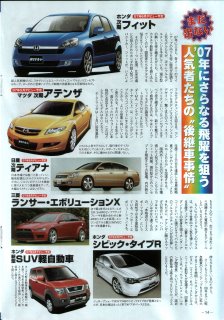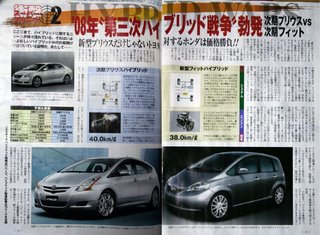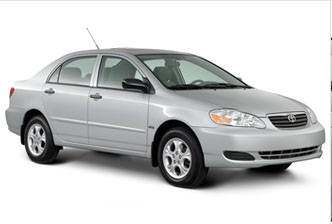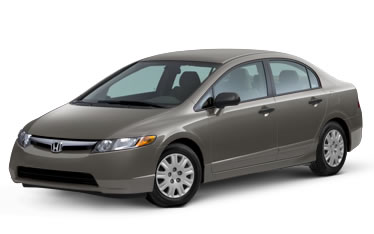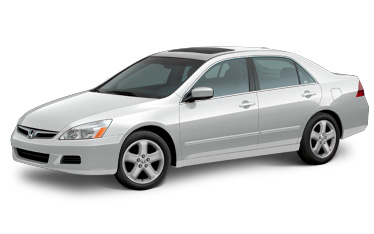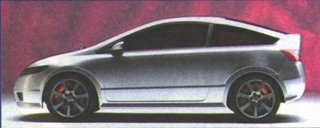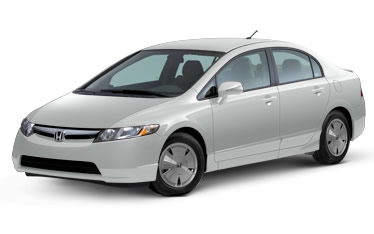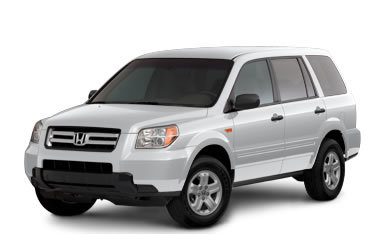 2nd place: Toyota Sienna LE
2nd place: Toyota Sienna LEThe Toyota Sienna is roomy, comfortable and does everything well. It's easy to live with and comes loaded with features that make life easier and more convenient. Everything operates exactly as people expect, so equipment struggles are rare. Its smoothness and convenience allows the vehicle to fade into the background while you go about your life.
On the road, the Sienna delivers a smooth ride, responsive handling, and brisk acceleration performance. Its 230-horsepower V6 engine and five-speed automatic transmission deliver responsive throttle response while variable valve timing assures good fuel economy. The Sienna is rated to tow up to 3500 pounds.
The Sienna has a strong reputation for safety. Front seat-mounted side-impact airbags plus side curtain airbags for all three rows are now standard on all models. A rear-view camera is available to help the driver spot objects or children behind the vehicle when backing up. All-wheel drive is available for more secure travel in foul weather well.
Completely redesigned for the 2004 model year, the Sienna features gets some upgrades for 2006. The styling has been freshened in the form of new headlamps and fog lamps, a revised grille, and redesigned tail lamps. A new power folding third-row seat for the Sienna Limited model makes switching from carrying people to cargo easier. The available rear-seat entertainment system features a larger, nine-inch LCD screen, while a universal mini-jack port now comes on all audio systems for connectivity to portable music players. New, power folding mirrors on 2006 Limited models feature puddle lamps and turn signals. New Optitron gauges, similar to those used by Lexus, come on 2006 LE, XLE and Limited grade
The Sienna LE ($25,130 US) is the most popular model. The LE comes with nicer cloth fabric, upgraded trim, the new Optitron instrumentation, and a host of convenience features: engine immobilizer, audio controls on the steering wheel, heated power mirrors, a roof rack, privacy glass, cruise control, driver's seat manual-adjustable lumbar support, illuminated vanity mirrors, color-keyed license plate garnish, and a fold-flat front passenger seat. The LE is available with all-wheel drive ($28,745 US). It's also available as a front-drive, eight-passenger model ($25,280 US). All Sienna AWD (all-wheel drive) models come with four-wheel disc brakes, electronic stability control and traction control, windshield-wiper de-icer, and P255/60R17 all-season run-flat tires on aluminum wheels.
There are tons of option packages. Of note for 2006, Sierra's optional rear seat entertainment screen has been increased in size from seven to nine inches.
Standard safety features include three-point seatbelts in all seats with adjustable seatbelt anchors for front- and second-row seats; driver and front passenger pretensioners and force limiters; height-adjustable head restraints in all seating positions; low tire-pressure warning system; child-protector sliding door locks; pinch protection function with auto-reverse on available power sliding doors; and a new LATCH (Lower Anchor with Tether for Children) system used in all second-row seating positions to accommodate new-design child seats. Standard safety equipment on all models includes front seat-mounted side-impact airbags for driver and front passenger and curtain airbags designed to provide head protection for all three rows of seats.
The Toyota Sienna boasts a roomy interior, with lots of space for passengers and cargo. Fold the second- and third-row seats flat and it can carry 4x8 sheets of plywood.
Getting in and out is easy. Sienna's power sliding doors and power rear liftgate work superbly. Step-in height is about six inches lower than that of the Sequoia SUV, a benefit when dressed up or dealing with toddlers or dogs, or just about every time you get in or out. The power sliding doors are smooth and quiet and move relatively quickly, a good feature when dealing with impatient passengers (and aren't they all impatient?). Manual sliding doors and the manual rear hatch on LE and CE models have a quality feel as well. But the power doors are a nice convenience.
The rear side windows lower partly, but not below the center of gravity of a toddler, and feature anti-pinch protection designed to reduce chance of injuries to small hands and fingers. A nice feature is the availability of sunshades for the second- and third-row seats, as they filter strong sunlight even better than privacy glass.
The driver sits before a smooth, organic dash, though the center stack looks a bit tacked on, especially with the faux-wood trim on the Limited model. The seats are comfortable, even for long drives. The steering wheel tilts and telescopes. Big mirrors and lots of glass give the driver a good view. The dash-mounted shifter seems unusual at first and has a bit of a spindly feel. The heating/air conditioning system works well and features dual front seat controls that are easy to sync by pressing a button. Switches for the power sliding doors and power rear liftgate are overhead.
Trim materials improve as you go up the line, but are of good quality even on the base CE model. The CE comes with a nice cloth interior, though the door inserts are plain. LE features nicer cloth, nicer door inserts, and other trim. XLE offers even better cloth. The Limited is upholstered in leather.
There are lots of cubbies for storage. Two glove boxes are provided. A big center console holds 12 CDs. Armrest compartments each hold six CDs, and there's a spot for a small cell phone just to the right of the shifter. The dry cleaning hooks look big enough to accomodate big loads. Hooks in back are provided for plastic grocery bags. A standard 115-volt outlet, like the kind in your house, is provided, allowing you to power computers or other small electronic appliances from your car, though a blow dryer might be pushing. All models come with a battery saver feature that deactivates the dome lights after 30 minutes, an important feature since minivans are often used with the doors open as all-day bases for picnics or outdoor activities.
The second row of seats is roomy. There's good space for legs, and an airy feel with welcome room next to the passenger's head. That's impressive, particularly with the Sienna's standard curtain-style airbags; they do not intrude into rear headroom as much as other designs. When not needed, the second-row seatbacks flip down and the seat bottoms tumble forward, presenting a friendly surface for cargo or pets. The second-row seats are mechanically easy to remove and reinstall, though the 49-pound captain's chairs may require two people to wrestle in and out.
Seven-passenger models use captain's chairs for the second row. The right-hand seat can be repositioned laterally (side to side), offering either a small bench seat or a pair of bucket seats with space between them. Moving them close together makes getting into the back row easier. Moving them apart makes them more comforable for adults. The seat has to be removed and reinstalled in one of two locations, however; it does not slide on tracks, which is a more costly design. Toyota says most people normally don't move the second-row seats once they've decided on the favored position. Unfortunately, this setup leaves the attachment points exposed. A neat feature is the center console that can be removed from between the front seats and relocated between the second-row seats. This leaves room for a bag between the front seats. Owners who want a center console in both locations can order a second unit from the dealer.
Eight-passenger models (available on the CE and LE) differ mainly in the second row, which is a three-way split/folding bench seat with a small middle section that can be moved nearly 13 inches closer to the front seats, putting children in child seats within arm's reach. When not being used, the center seat converts into a big armrest.
Third-row seats have a rake adjustment, which improves their comfort. The third row is split 60/40 for added versatility when hauling a combination of passengers and cargo, long items for example. Sienna offers more space behind the third row than most minivans. The third-row seatbacks flip forward, then each seat folds easily into a deep well when not needed, a two-step operation that can be done with one hand. Headrests are integrated into the seats so they don't have to be removed as on some minivans, but it's very important to remember to pull the headrests back up when putting passengers back there, something that's easy to neglect. Folding the third row away leaves a flat cargo floor with tie-down hooks. We were able to slide in a six-foot ladder without moving the second-row seats.
The Toyota Sienna boasts a smooth ride and responsive handling, striking a good balance between the two. Smooth and responsive describes the powertrain as well. It all adds up to a vehicle that's enjoyable to drive, whether on long trips or for quick errands, loaded with people or by yourself.
The Sienna accelerates relatively quickly, 0 to 60 mph in 8.3 seconds, according to Toyota, performance that's more than adequate for most traffic conditions. Toyota's 3.3-liter V6 features a two-stage variable-valve setup, called VVT-i or Variable Valve Timing with intelligence, for good torque at both low rpm and high rpm, and significantly improved fuel economy (by 3 mpg over pre-2004 models).
A smooth-shifting five-speed automatic transmission adds to the Sienna's responsiveness around town and on the highway. The five-speed automatic helps with fuel efficiency, achieving an EPA-estimated 27 mpg on the highway test. Sienna runs clean, too, clean enough for Ultra Low Emissions (ULEV II) certification. Toyota recommends premium fuel, but the Sienna will run on regular.
Braking is smooth and powerful. Making big 16-inch wheels standard equipment allowed Toyota to design bigger brakes. Four-wheel anti-lock brakes (ABS) with Electronic Brake-force Distribution (EBD) and Brake Assist come standard. ABS helps to prevent the brakes from locking during severe braking conditions. EBD distributes the braking force to the tires with the most weight on them for quicker, more stable stops. Brake Assist adds brake pressure during emergency stopping situations when the driver mistakenly reduces pedal pressure.
Vehicle Stability Control (VSC) with Traction Control (TRAC) is optional. Vehicle Stability Control utilizes the braking system to help the driver maintain control in adverse driving conditions. Traction control helps reduce tire slippage during acceleration. All-wheel drive adds greatly to all-weather capability and recommend it for anyone who drives in wintry conditions or heavy rain. In normal driving on dry pavement, we could not discern much difference in ride quality between front- and all-wheel drive models. That's in spite of the fact that AWD models come with 17-inch run-flat tires. Run-flat tires are equipped with reinforced sidewalls with a special bead shape to permit driving for up to 100 miles at speeds up to 55 MPH even when all the air pressure is lost. We associate run-flat tires with a rougher ride quality but they're improving all the time. Run-flat tires can significantly improve safety by eliminating the need to stop to change a tire in an unsafe location. A spare tire is available for all-wheel-drive models.
The Toyota Sienna is among the best of the minivans available today. It's powerful yet frugal, and attractively designed. It handles well yet rides smoothly. This is a big van with a roomy, comfortable interior that offers versatile seating configurations and a generous cargo bay. It's equipped with the latest safety features, including curtain-style airbags. And it's backed by Toyota's reputation for quality, durability and reliability.
 1st place: Honda Odyssey EX
1st place: Honda Odyssey EXThe Honda Odyssey has been a bestseller ever since the second generation was introduced in 1999. When the all-new third generation was introduced as a 2005 model, Honda showed it wasn't resting on its laurels. Instead, Honda listened to Odyssey owners and adopted their suggestions in this latest model.
Odyssey boasts car-like ride and handling, a powerful and fuel-efficient 244-horsepower V6 engine, and a clever seating system that can accommodate up to eight passengers.
Odyssey comes standard with side curtain airbags, electronic stability control, and anti-lock brakes, and the body structure is designed to offer improved crash protection.
Completely redesigned for 2005, the Odyssey carries on with few changes for 2006.
The EX ($28,395 US) adds power sliding doors, tri-zone climate control, a stowable second-row PlusOne seat, in-dash CD changer, steering wheel audio controls, power driver seat controls, alloy wheels and other features. Leather upholstery is available by ordering the EX with leather ($30,000 US), a model that includes the iVTEC engine with variable cylinder management (VCM), a power moonroof and heated front seats.
Inside, the Honda Odyssey is comfortable and convenient. It feels downright luxurious when ordered with leather trim. The materials are nice and the metallic-colored trim that runs across the center dash is attractive.
The driver's seat is designed to hold the driver more firmly and is positioned in a car-like setting. Power-adjustable pedals are available in the Touring model. The shift lever is mounted on the dashboard; it looks odd at first, but it's easier to use than a column-mounted shifter. A handy drink tray is provided between the front seats, but there's no center console.
The second-row bucket seats are comfortable.
The third-row seat is split 60/40 and folds easily into the well provided for it, and the headrests do not need to be removed before folding.
There's room for eight people with the optional PlusOne seat that fits between the two captain's chairs in the second row. If it's not needed as a seat it can be turned into a table or stowed in the floor in place of the Lazy Susan bin. If the PlusOne seat is not being used, the right-hand seat can be slid across to allow easier access to the third-row seats. This flexibility makes the Odyssey a versatile people hauler, but it's not the best in the class for hauling cargo.
The optional voice-activated DVD navigation system includes Zagat restaurant data. The large eight-inch monitor is positioned high on the dashboard for easy viewing. The voice-activated system responds to 637 commands and is smart enough to understand different accents and find locations without any need for input other than by voice. Apart from navigation, the system can be used to operate the radio and climate controls. We found the system responds effectively to voice commands.
The available DVD entertainment system features a large nine-inch widescreen display that folds out of the ceiling. For 2006, the DVD system comes standard on Touring models (previously it was only available with the navigation system). The wireless headsets turn on and off automatically as the ear pads are rotated. For 2006, XM Satellite Radio is standard on Touring models.
Who'd ever think of putting a Lazy Susan in a minivan? Honda has. No, it's not for serving food, but for adding an incredibly useful hidden storage area. The previous Odyssey had a storage well under the floor of the front seats for the spare tire. Honda engineers have moved the spare to a location in the rear. Instead of removing the round space under the floor where the spare used to reside they've turned it into a hidden storage compartment with a rotating compartmentalized bin. There's a small access panel in the floor between the two front seats for front passengers to get access and another bigger one in front of the center-row seats for access. So whatever stuff is stowed in the Lazy Susan, front or middle-row passengers can turn it for access. Ingenious!
Not as ingenious are the two glove boxes, which are more awkward for storage than one big one.
Underway, the Honda Odyssey delivers everything you could ask for in a minivan: a smooth ride, responsive handling, stability at speed and a smooth, powerful engines. Honda's goal with this latest-generation model was to produce a minivan with the handling of a European sedan.
The Odyssey belies its size on the road and handles like a premium sedan. It's not as dynamic as a European sports sedan, of course, but it's certainly better than an SUV. We found its handling and ride pleasant for long drives as well as around town.
During a test drive along country roads near the Honda factory in Alabama, we found the Odyssey offered a perfectly pleasant ride. It was neither too firm nor too soft. Granted, there is some road vibration. And there is some slack in the steering on-center: You can turn the steering wheel a few degrees in either direction before the vehicle starts to move. It was no worse than in a Chrysler Town & Country, however, and many people will not notice as it's a common trait of many large cars and most SUVs. All in all, it's an ideal vehicle for a long-distance drive.
Several laps around a race track showed the Odyssey to be stable at high speeds. And I was surprised how much we could chuck it into corners. We found we could drive hard enough into a sharp corner to feel the tires slip without any drama. We could not feel much body roll (lean) in corners, and an Odyssey lapping in front of us looked remarkably stable for a tall vehicle.
Parking is easy. The turning radius is among the tightest of any minivan, making it an easy to make U-turns and maneuver in parking lots. The park-assist system, with beeping tones that warn the driver of other bumpers front and rear, helps considerably when parallel parking.
Straight-line acceleration is good, better than other minivans. Yet despite having 244 horsepower going through the front wheels, the Odyssey is almost devoid of any torque steer.
The Odyssey's 3.5-liter V6 engine is smooth, powerful, clean and fuel efficient. The iVTEC V6 (intelligent Variable Timing and Electronic Control) that comes on the EX with Leather and the Touring model gets an EPA-rated 20/28 mpg City/Highway, which is better fuel economy than the standard VTEC that comes on the LX and EX, 19/25 mpg. The iVTEC engine does this by deactivating three of the six cylinders whenever you're cruising. We were never able to discern when the engine was running on three cylinders as there is no visible lurching or change in engine note, although a green dash light illuminates to tell you the system is working. Both versions of the V6 generate the same amount of power: 244 horsepower and 240 pound-feet of torque (though the iVTEC generates its peak torque at 4500 rpm vs. 5000 rpm for the VTEC). If it looks like horsepower figures are lower for 2006, it's due to a change in how the Society of Automotive Engineers tests engines. No change has actually been made to the engines.
The brakes work well. Every Odyssey comes with anti-lock brakes (ABS) and Vehicle Stability Assist, Honda's electronic stability control system. This system works in conjunction with the drive-by-wire accelerator and ABS to modulate the brakes while managing the throttle and ignition. If the vehicle starts to lose grip on a tight turn on a slippery surface, the system automatically slows the engine and gently applies brakes to stop the vehicle from skidding out of control. In a test on a soaking skid pad we found the system works well. Fortunately it only works in emergency situations so it's not distracting during normal spirited driving. It can be turned off, though we recommend against doing so.
Booming road noise, especially from the rear seats, was a common complaint of the previous-generation Odyssey. Honda claims that the current vehicle is much quieter with increased amounts of sound-deadening material and floating sub frames that keep suspension and tire noise more isolated. We had no complaints about noise while driving the different models. The Touring model and the EX with leather benefit from high-tech noise-abatement features. When the i-VTEC engine with VCM is only running on three cylinders there is a natural imbalance, which can produce drumming sounds and vibrations. To counteract this, the engine is mounted on special active control engine mounts that electronically adjust themselves to counteract engine vibrations. Further booming sounds are reduced by an active noise control system that automatically sends an out-of-phase sound through the loudspeaker system to cancel out engine noises; it also works when the engine is idling.
Anyone who appreciates the versatility of a minivan coupled with the driving characteristics of a car will delight in owning a Honda Odyssey. The Touring model is especially compelling for drivers who a versatile luxury utility vehicle that rides like a car. Perhaps that's why Honda calls its Odyssey a premium adventure vehicle.
So in the all, the Odyssey is still better than the Sienna.
